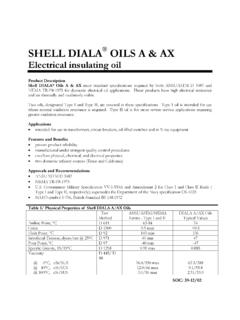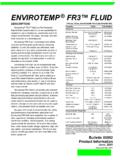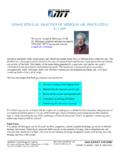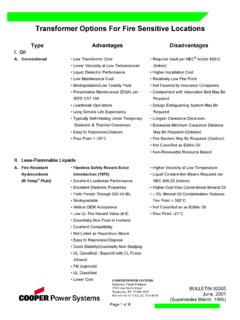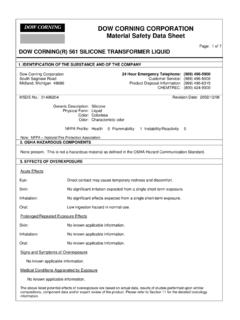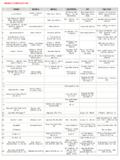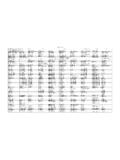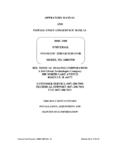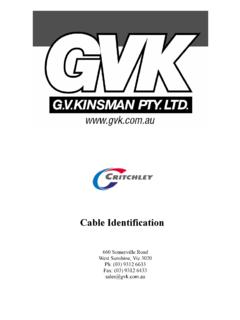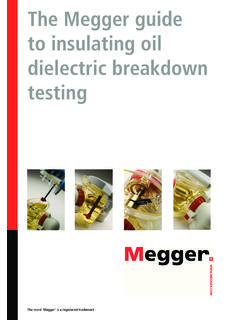Transcription of Shell Canada Limited Material Safety Data Sheet
1 Page 1 of 4 Shell Canada Limited Material Safety data Sheet Effective Date: 2008-10-30 Supersedes: 2005-11-15 1. PRODUCT AND COMPANY IDENTIFICATION PRODUCT: DIALA* A X PRODUCT USE: Electrical Insulating Oil PRODUCT CODE: 407-651 SUPPLIER TELEPHONE NUMBERS Shell Canada Limited (SCL) Shell Emergency Number 1-800-661-7378 Box 100, Station M CANUTEC 24 HOUR EMERGENCY NUMBER 1-613-996-6666 400-4th Ave. For general information: 1-800-661-1600 Calgary, AB Canada T2P 2H5 This MSDS was prepared by the Toxicology and Product Stewardship Section of Shell Canada Limited . *An asterisk in the product name designates a trade-mark(s) of Shell Canada Limited , used under license by Shell Canada Products.
2 2. COMPOSITION / INFORMATION ON INGREDIENTS THIS PRODUCT IS NOT A WHMIS CONTROLLED SUBSTANCE. See Section 8 for Occupational Exposure Guidelines. 3. HAZARDS IDENTIFICATION Physical Description: Liquid Lightly Coloured Slight Hydrocarbon Odour Routes of Exposure: Exposure will most likely occur through skin contact or from inhalation of mechanically or thermally generated oil mists. Hazards: This product is not expected to be irritating and has a low level of toxicity under normal use. Ingestion may result in vomiting. Avoid aspiration of vomitus into lungs as small quantities may result in aspiration pneumonitis. Inhalation of oil mist or vapours from hot oil may cause irritation of the upper respiratory tract.
3 For further information on health effects, see Section 11. 4. FIRST AID MEASURES Eyes: Flush eyes with water for at least 15 minutes while holding eyelids open. If irritation occurs and persists, obtain medical attention. Skin: Wipe excess from skin. Wash contaminated skin with mild soap and water for at least 15 minutes. If irritation occurs and persists, obtain medical attention. If Material is injected under the skin, get medical attention promptly to prevent serious damage; do not wait for symptoms to develop. Ingestion: Not normally required; obtain medical attention if large amounts have been ingested. Do DIALA* A X 407-651 Revision Number: 6 Page 2 of 4 not induce vomiting.
4 If vomiting occurs spontaneously, keep head below hips to prevent aspiration of liquid into the lungs. Inhalation: Remove victim from further exposure. Additional first aid treatment is not ordinarily required. Notes to Physician: In general, lubricating oils have low oral toxicity. High pressure injection under the skin may have serious consequences and may require urgent treatment. 5. FIRE FIGHTING MEASURES Extinguishing Media: Dry Chemical Carbon Dioxide Foam Water Fog Firefighting Instructions: Caution, spilled Material is slippery. Material will not burn unless preheated. Product will float and can be reignited on surface of water. Do not use a direct stream of water as it may spread fire.
5 Use water to cool fire exposed containers. Water may be used to flush spills away from exposure. Do not enter confined fire space without adequate protective clothing and an approved positive pressure self-contained breathing apparatus. Hazardous Combustion Products: Carbon monoxide, carbon dioxide and dense smoke are produced on combustion. 6. ACCIDENTAL RELEASE MEASURES Isolate hazard area and restrict access. Avoid prolonged or repeated contact with skin. Wear appropriate breathing apparatus (if applicable) and protective clothing. Stop leak only if safe to do so. Spilled Material is slippery. Dike and contain land spills; contain spills to water by booming. For large spills remove by mechanical means and place in containers.
6 Adsorb residue or small spills with adsorbent Material and remove to non-leaking containers for disposal. Notify appropriate environmental agency(ies). After area has been cleaned up to the satisfaction of regulatory authorities, flush area with water to remove trace residue. Dispose of recovered Material as noted under Disposal Considerations. 7. HANDLING AND STORAGE Handling: Avoid excessive heat, formation of oil mist, breathing of vapours and mist of hot oil and prolonged or repeated contact with skin. Launder contaminated clothing prior to reuse. Wash with soap and water prior to eating, drinking, smoking, applying cosmetics or using toilet facilities. Use good personal hygiene.
7 Storage: Store in a cool, dry, well ventilated area, away from heat and ignition sources. 8. EXPOSURE CONTROLS / PERSONAL PROTECTION The following information, while appropriate for this product, is general in nature. The selection of personal protective equipment will vary depending on the conditions of use. OCCUPATIONAL EXPOSURE LIMITS (Current ACGIH TLV/TWA unless otherwise noted): North American exposure limits have not been established for the product. Consult local and provincial authorities for acceptable values. Oil mist (mineral): 5 mg/m3 (STEL: 10 mg/m3) Mechanical Ventilation: Not normally required. Local ventilation is recommended if oil mist is present or if exposure limit is exceeded.
8 Make up air should always be supplied to balance air exhausted (either DIALA* A X 407-651 Revision Number: 6 Page 3 of 4 generally or locally). PERSONAL PROTECTIVE EQUIPMENT: Eye Protection: No special eye protection is routinely necessary. Wear Safety glasses as appropriate. Skin Protection: Not normally needed. Chemically-resistant gloves should be worn for frequent or prolonged contact with this product. Respiratory Protection: Not normally required under intended conditions of use. If airborne concentration is high ( when product is heated), use a NIOSH-approved chemical cartridge respirator with organic vapour cartridges in combination with a P95 particulate filter. 9.
9 PHYSICAL AND CHEMICAL PROPERTIES Physical State: Liquid Odour: Slight Hydrocarbon Odour Appearance: Lightly Coloured Odour Threshold: Not available Pour Point < -40 C Boiling Point > 149 C Vapour Pressure (absolute): < mm Hg @ 20 C Vapour Density (air = 1): Not available Density: Flash Point COC = 146 C Specific Gravity (Water = 1): Lower Flammable Limit: Not available pH: Not available Upper Flammable Limit: Not available Viscosity: < 10 cSt @ 40 C Auto-ignition Temperature: Not available Evaporation Rate (n-BuAc = 1): Not available Partition Coefficient ( log KOW): Not available Water Solubility: Insoluble Molecular Weight: Other Solvents: Hydrocarbon Solvents Formula: 10.
10 STABILITY AND REACTIVITY Chemically Stable: Yes Hazardous Polymerization: No Sensitive to Mechanical Impact: No Sensitive to Static Discharge: No Hazardous Decomposition Products: Thermal decomposition products are highly dependent on combustion conditions. Incompatible Materials: Avoid strong oxidizing agents. Conditions of Reactivity: Avoid excessive heat, formation of vapours or mists. 11. TOXICOLOGICAL INFORMATION Routes of Exposure: Exposure will most likely occur through skin contact or from inhalation of mechanically or thermally generated oil mists. Irritancy: This product is not a primary skin irritant after exposure of short duration, is not a skin sensitizer and is not irritating to the eyes.
